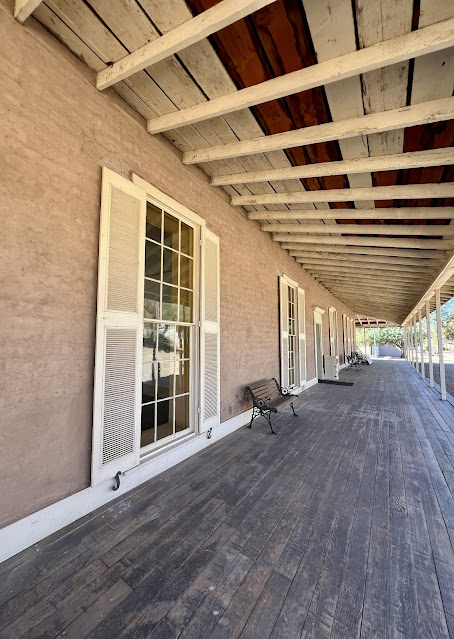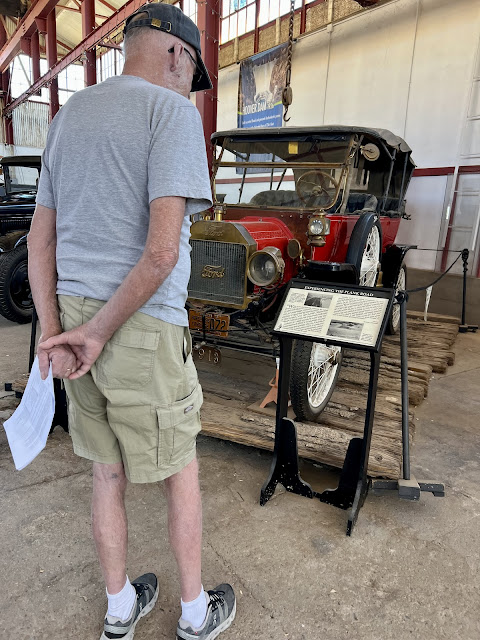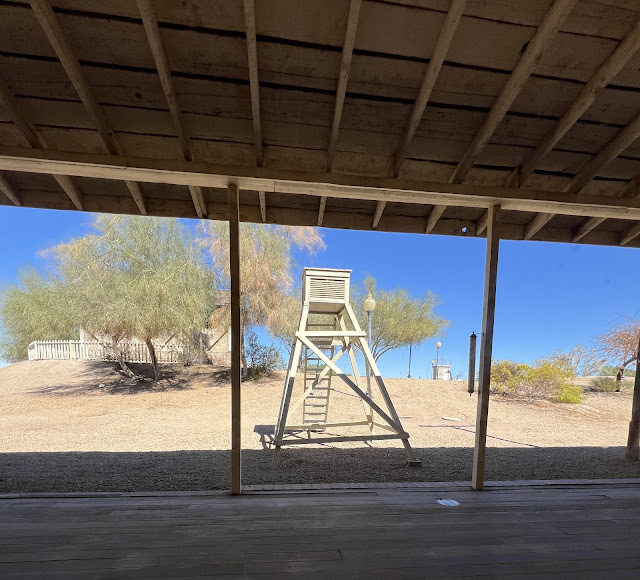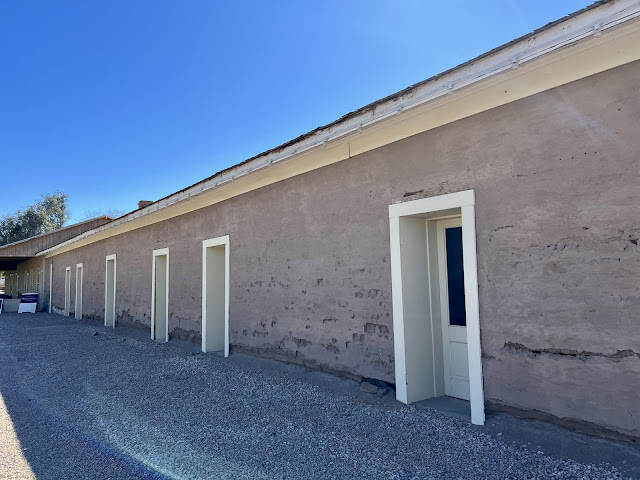Cocopah RV Resort
Yuma,AZ
February 22, 2025
 |
| Sunset at Cocopah...walking Lucy |
Saturday's adventure was a history lesson and a yummy lunch at one of the points of interest in the Yuma Crossing National Heritage Area along the Colorado River.
 |
| The bluff overlooking the Colorado River... |
Yuma began to experience the American westward movement in the mid 1800s when over 60,000 people crossed by ferry from Yuma on their way to California in search of gold. A military post was established in Yuma in 1850 and the Colorado River Historic State Park is located on the bluff overlooking the river on the site of the U.S. Army Quartermaster Depot established in 1864. The purpose of the park is to protect its historic structures and interpret the diverse history of the area.
 |
| The Quartermaster Depot...front porch with the river below. |
The Depot served as a storage yard and a military supply center for fourteen military posts in Arizona, New Mexico, Nevada, Southern Utah, and West Texas. There was a six month's supply of ammunition, clothing, and food at all times. The supplies were brought from California by ocean-going vessels traveling around the Baja Peninsula and then north as far as the mouth of the Colorado River. At this point, supplies were transferred to river steamboats and brought up the river to the Depot. There sere several displays in side the Quartermaster's Office including uniforms and offices for the Quartermaster, and a military telegrapher from the Signal Corp. In 1873, the U.S. Signal corps operated Arizona's first non-private telegraph line from this office. The telegraph stretched from San Diego, through Yuma, and on to Prescott and Tucson. But the most interesting bit of history to us was the Weather Station was also housed in this Depot.
The Quartermaster's Office at the Yuma Depot became the first Signal Service weather station in Arizona Territory.
Other points of interest include :
the Water Reservoir
the Corral House
 |
| I peeked in one of the doors...it's been awhile since 1951...I know because I was born that year. No one has occupied it since. |
the Quartermaster's House and Kitchen
 |
| The dining room and door to the kitchen... |
 |
| The kitchen and laundry room... |
 |
| The kitchen garden had veggies and herbs... |
the Storehouse
 |
| Wagon wheel on a dump wagon... |
 |
| The mule drawn fire wagon... |
 |
| Army military wagon... |
 |
| 1913 Model T Ford on a plank road... |
 |
As you can tell, the storehouse was our favorite part of this very informative historic state park. We are happy we went and checked off another great Arizona Sate Park. Unlike other state parks we have visited, this park has a yummy Italian Restaurant. It is located in the Corral House with inside and patio sitting.
Starlings were first brought to North America in the 1890s...in fact all the Starlings in North America descended from 100 birds let loose in Central Park in NY. They are now among the continent's most numerous songbirds.These common birds are great vocal mimics and have up to 20 different bird species calls.
Starlings turn from spotted and white to glossy and dark each year without shedding their feathers. They grow new feathers in the fall with bold white tips and by spring the tips have worn away. That's pretty cool and I don't ever remember seeing a Starling with its spots.
 |
| So pretty! And so very fast...these birds with their short tails and triangular wings can fly up to 48 MPH. |
Lucy is such a joy...a great little travel puppy !















You always write such a good blog and I learn something each time I read your blog. Lucy is adorable and great picture of her meeting another pup.
ReplyDeleteThank you! Lucy is busy socializing when we walk and go to the grassy puppy area. She loves everybody…two legs and four legs! Thank you for your comment…
DeleteGood morning Gay -I learned more about Starlings in a 5 minute read of your blog than in living all this time!
ReplyDeleteI really appreciate the effort AZ has put into maintaining the park and it's history.
When Fran and I visited I do not recall there being a restaurant.
Good morning Jeff…I didn’t ever recognize that bird as a Starling. I have never seen/noticed one with the white dots before. I do find nature interesting! I thought of you and Fran along with others I know who enjoy a glass of wine as the small cafe had a long list of wines imported from Italy. I just read this morning that AZ parks are increasing their prices which makes me happy because the rangers are the ones who have not had increases in their small salary in a long time. The maintenance, projects, etc. have been at the top of the list instead. We are happy to pay alittle more!
DeleteI am loving your tour of Yuma! And an Italian restaurant inside a state park--bonus! And I'm with Jeff--I learned a lot about starlings!
ReplyDeleteHi Janna…thank you! We were pleasantly surprised to find a great place to have a light lunch at the park before heading home. Hope you and Mike are feeling better…
DeleteWhat a great piece of "local" history. They've really saved a lot for the telling and showing of the story. Love the wagon wheel and the red bell frame - wonderful art! I must have a Pinsa some day, yummy! So glad Miss Lucy has embraced the traveling and visiting life. She's adorable. I didn't realize Starlings have those cool spots and their color changes are amazing.
ReplyDeleteGood morning Jodee...Colorado River Historic SP is a great place to spend a few hours. It was our first Pinsa and I will be looking for recipes when we get home. Everything is new to Miss Lucy and what fun it is watching her discover new people, pups, noises, surroundings, etc. and it makes us very happy to to know (at least so far in her short life) that she is happy and feels secure.
DeleteGreat tour, complete with lunch! Thanks Gay. I love to see the photos of sweet little Lucy's progress, what a doll girl she is!
ReplyDeleteHi Sue…Lucy says, “thank you,” and I do too! She changes everyday as I am sure you are well aware of. Never having had a baby puppy before, Joe and I are just in awe of her!
Delete